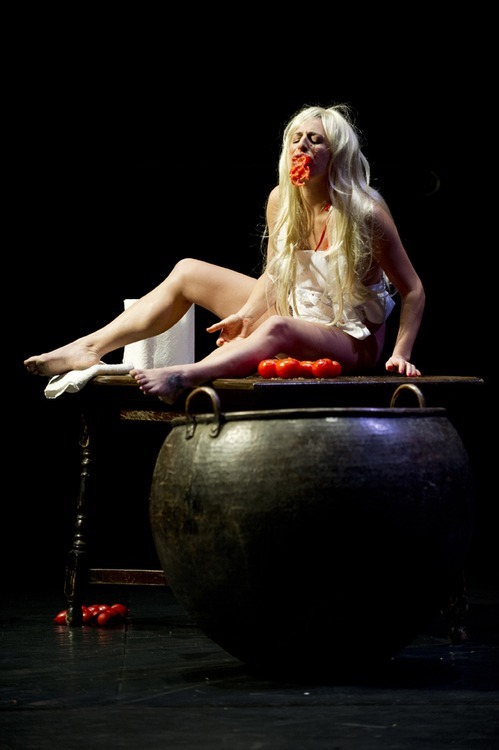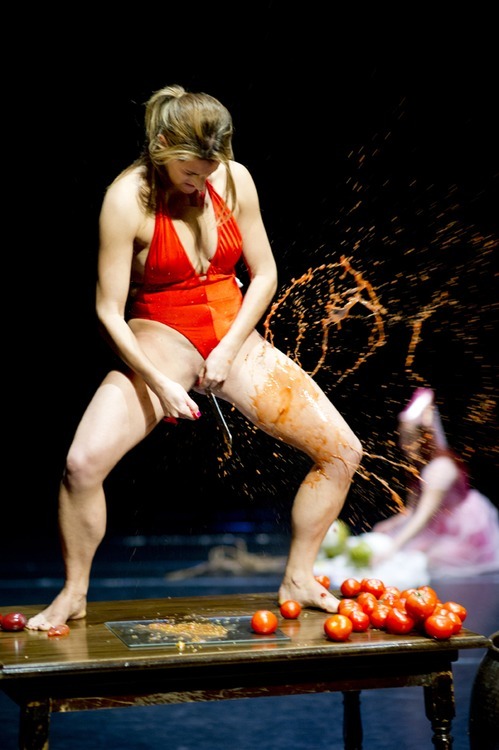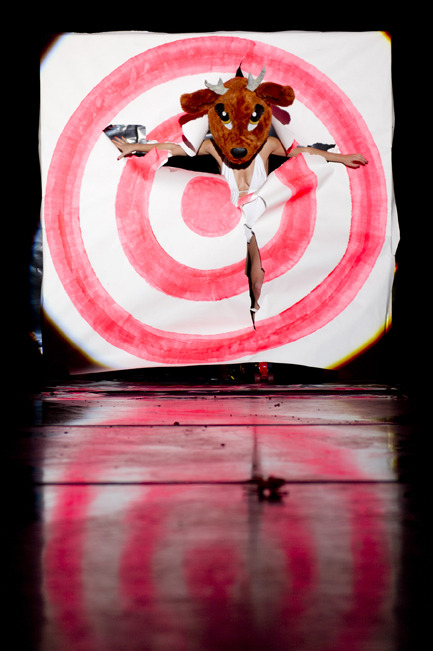by Mary Paterson
A figure roller-skates blindly across the stage, her vision obscured by a giant deer mask, her arms flailing at either side, her voice singing karaoke-style to a Disney ballad. Half girl, half Bambi, the skidding ingénue slips and slides over tomato juice, topples, wavers and almost falls, before a team of assistants rushes to her aid.
This scene is one of a dizzying array of feminine stereotypes played outrageously by The Famous Lauren Barri Holstein in Splat! Here, she parodies a cutesy cartoon princess, held up (literally) by an entourage who whose devotion simply highlights her dependence on others. Elsewhere, the performer and her semi-naked, female assistants perform a range of roles including bad tempered porn star, mute doll, exploited sex object, fairy-tale narrator, murdered body and soppy victim of heartbreak.
For Lauren Barri Holstein, the acting starts before the show begins. ‘The Famous …’ is, of course, a self-declared star. What she is famous for is not important - her name, like the products of her visual metamorphoses, is both a statement and an ambition. And, just like those visual changes, this declaration is less a form of identity than a claim to objecthood. By describing herself as ‘The Famous …’ Lauren Barri Holstein sets out how she wants to be seen. She’s not a woman play acting at celebrity – she is the very expression of fame. She’s not a woman who happens to be dancing (whether she’s performing in the guise of a Disney lead, a figure from an 80s film, or a demented R&B star) – she is the eternal dancing girl.

Even the artist’s desperation to be seen is a kind of parody-paradigm of femininity . As John Berger wrote in 1976, “men act, women appear”, so controlling what other people see is, in a twisted way, how women can access the means of their own production. Lauren Barri Holstein struts across stage like an early-80s Madonna, adopting a bossy demeanour (she orders her assistants around like slaves), an air of affected boredom (she moves between scenes as if it’s a burden to be there) and a casual, erotic awareness of her own image-making.
But ventriloquism is a precarious kind of identity.
As part of this image control, Lauren Barri Holstein forces her parade of underdressed assistants to film her travails, projecting a close up of her squashing tomatoes between her thighs, for example, to a large screen at the back of the stage. But there is also a single, male, fully dressed photographer who lurks around the edges of the show. This man does not seem to be under the star’s control. He photographs Lauren Barri Holstein even when she asks him to leave, and his photos remain hidden inside his camera. In a single moment, the iconic 80s Madonna becomes a vulnerable noughties Jordan, her picture taken and reused by those who don’t recognise her objecthood as power.
Indeed, it’s the relationship between objecthood and power that sits at the centre of Splat! Or rather, it writhes around in a vat of tomato juice, either waving or drowning. With each new identity that Lauren Barri Holstein shrugs on like an invisibility cloak, Lauren Barri Holstein herself disappears. This is partly because of the dramatic pointlessness of the task – it is of course a mainstay of feminism that a person cannot exist within a series of roles typecast from the outside. But the disappearance is also because the accumulated effect of multiple identities breaks down the mirage of appearance itself. Now a sexual predator, now a perpetrator of misogyny, now a fetish of desire, the variety of objecthoods Lauren Barri Holstein puts on display undermines any claims they have to representation. If a woman is either a virgin or a whore, then what are you looking at when you see her slip gracelessly between the two?

Another way of describing this variety could be as a kind of excess - Splat! is an excess of (tropes of) femininity, baring their bones until their guts spill, lifeless, onto the floor. And excess is indeed the defining principle of the show: each scene explodes with more bodies, more representation, more confusion.
But, inside Splat, excess becomes a kind of trope as well. Or, more accurately, this excess is not so much excessive, as conventional – albeit conventional in an alternative, performance art kind of way. The food-mess poured over young bodies recalls the artist Carolee Schneemann’s seminal performances like Meat Joy (1964)for example, while Lauren Barri Holstein’s impatient persona draws obvious comparison to the artist Ann Liv Young. Long passages in Splat are spent reading an alternative fairy tale in which a pliant female character explores the pleasures and dangers of her sexuality – a shadow, perhaps, of a revision by the feminist author Angela Carter.
In this context, it’s unclear whether excessive behaviour is being parodied as one more feminine trope that has been normalised beyond meaning, or whether it’s appearance is a genuine grab for power.
On one hand, these behaviours are now part of the encyclopaedia of voices available to women – identify with a pop star, or a princess, or a 1960s performance artist. But, just like Madonna’s 80s attitude, their efficacy has been dulled by distance from the socio-political context in which they were conceived. On the other hand, these devices of excess have a special status within Splat!: they define its structure and limit its content. Food-blood-bodily fluids accumulate onstage throughout, the fairy tale pulls the only narrative thread, and each new scene adds to a catalogue of excessive representations. As I watch the chaos pile up on stage, I wonder if Lauren Barri Holstein is making fun of the styles of radical feminist performance art, with the same wide eyed cruelty she uses to pull apart Disney’s saccharine charm. Or has she mistaken the tropes of stylistic excess for real power?

None of Lauren Barri Holstein’s relationships are simple. She seems to hold genuine affection for power ballads, princess dresses and roller-skating Bambis, even while she squashes their dreams like melons dropped from a great height. So perhaps it is only my prejudice that imagines she takes the sacred cows of performance art too seriously. Unlike Disney, I hold Carolee Schneemann to be important and admirable, and while I can laugh at Disney in almost any context, Schneemann commands a different kind of attention. But I also know that what was radical in 1964 is not radical in 2013; the grandmothers (or even the aunts and sisters) of feminist performance art cannot be copied, only revised. I long for someone with a name like ‘The Famous Lauren Barri-Holstein’ to tell me what feminism can be, what women can be, in the twenty first century.
But of course, that’s not her job. I’m sure if you asked her, Lauren Barri Holstein would say she’d rather hang upside down and eat a hamburger. The show ends with what can only be described as a masterstroke of visual spectacle, and it’s at moments like this – brash, bizarre and fiercely independent – that ‘The Famous …’ lives up to her self declared name.

















